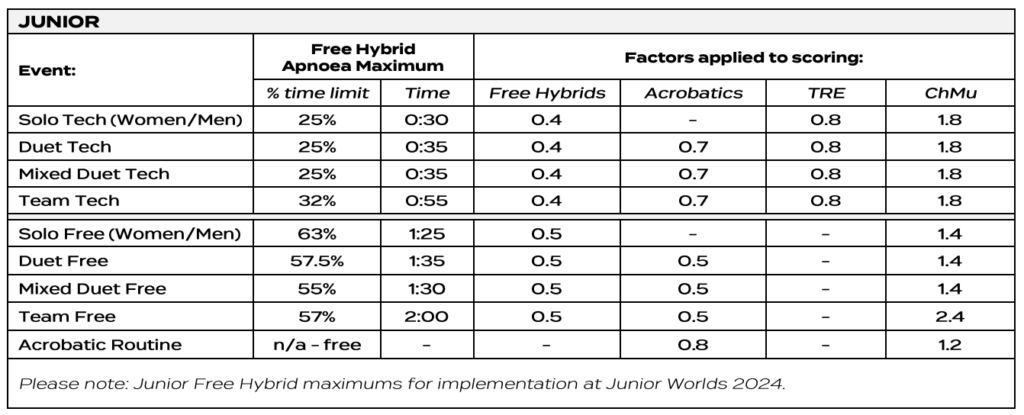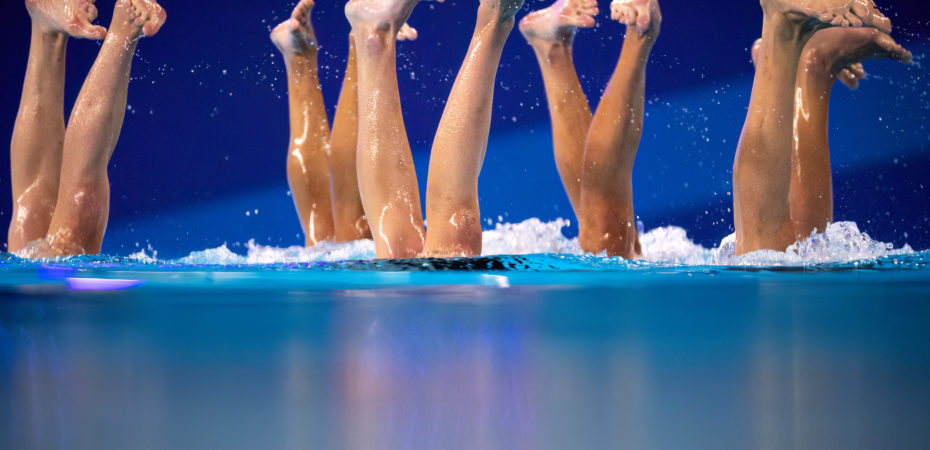World Aquatics has made additional changes to the construction of the Degree of Difficulty (DD) for free hybrids in artistic swimming routines. A limit has been implemented in the numbers of Thrusts (T) and Rotations (R) families from levels 5-9 per hybrid.
In addition, Free Hybrid Apnea Maximums are being introduced for 2024. At this time, only the junior, youth and U12 levels are affected.
These changes are effective as of March 1.
HYBRID DIFFICULTY LIMITS ON T5-9 AND R5-9
In this latest update to the hybrid difficulty table, a cap has been implemented on the number of Thrusts and Rotations in levels 5 – 9.
From now on, it is only possible to declare movements in the R5 – R9 families and T5 – T9 families a maximum of three times per technique, per hybrid.
Using an easy example, let’s imagine a free hybrid declared as: R7 R7 R5 R7 R7 R5. If three R7 are “Two-direction Twist 360°”, and the fourth one is an “Unbalanced 360° Twist”, it is fine. If all four R7 are “Unbalanced 360° Twists”, then it is incorrect and cannot be declared.
Essentially, this change is to put a pause to the “Two-direction Twists 360°” craze we saw in the last few meets, including the Doha World Championships. Endlessly declaring the same movements (most often, R7s) in one hybrid is no more possible. This change should hopefully encourage slightly more variety within a single hybrid, for the time being.
APNEA TIME LIMITS
Limits on the time spent in apnea during free hybrids are being introduced as well. For now, only the junior, youth and U12 levels are affected. Maximums will be considered for the senior level for the 2025 season.
Across the three age groups, athletes can only spend more or less 50% of the time limit of a routine in apnea to perform their free hybrids. In the junior technical routines, it is even less and equals to 25% – 32% of the routine, depending on the event, as there are fewer free hybrids required.
For example, let’s look at a free solo in the junior category. 1:25 of the 2:15-minute routine can be spent in apnea to perform free hybrids. Remember that this routine should also contain seven free hybrids. This means that each free hybrid must more or less last about 12 seconds.
Time underwater for free hybrids will be calculated from breath taken into hybrid entry to first breath surfacing after completing the hybrid.
Find below the tables pertaining to each age group:



As noted, these changes will be implemented by World Aquatics for the World Junior Championships, set for the end of August. However, the European Youth and European Junior Championships are scheduled for earlier in the year. It is possible that European Aquatics may implement these time limitations for their competitions, but it remains to be confirmed.
Additionally, there will be a 40-point bonus (!) available to all routines who are within the required Free Hybrid Apnea Maximums. That bonus will be applied to the routine score.
At the time of publication, World Aquatics has not yet published the two official documents pertaining to these changes. All national federations have however been informed and received internal communication on the matter.
Edit (March 31): The updated Difficulty Guide (v. 4.2) is up on World Aquatics’ website.
ARTICLE BY CHRISTINA MARMET
Cover photo: Giorgio Perottino / Deepbluemedia
If you’ve enjoyed our coverage, please consider donating to Inside Synchro! Any amount helps us run the site and travel costs to cover meets during the season.


Thank you. Going to be complicated to monitor this in a routine. Presume a second set of timekeepers are now required? And penalties still need to be set. Increases the number of officials needed which loads extra stress for small countries. It also may open room for more appeals and time consuming reviews.
Grazie
Do you know how the time underwater is counted if you start your first hybrid from jumping into the water and then without taking a breath start hybrid? Is it counted like it was when time underwater counted as part of BM – so from first move of the hybrid?